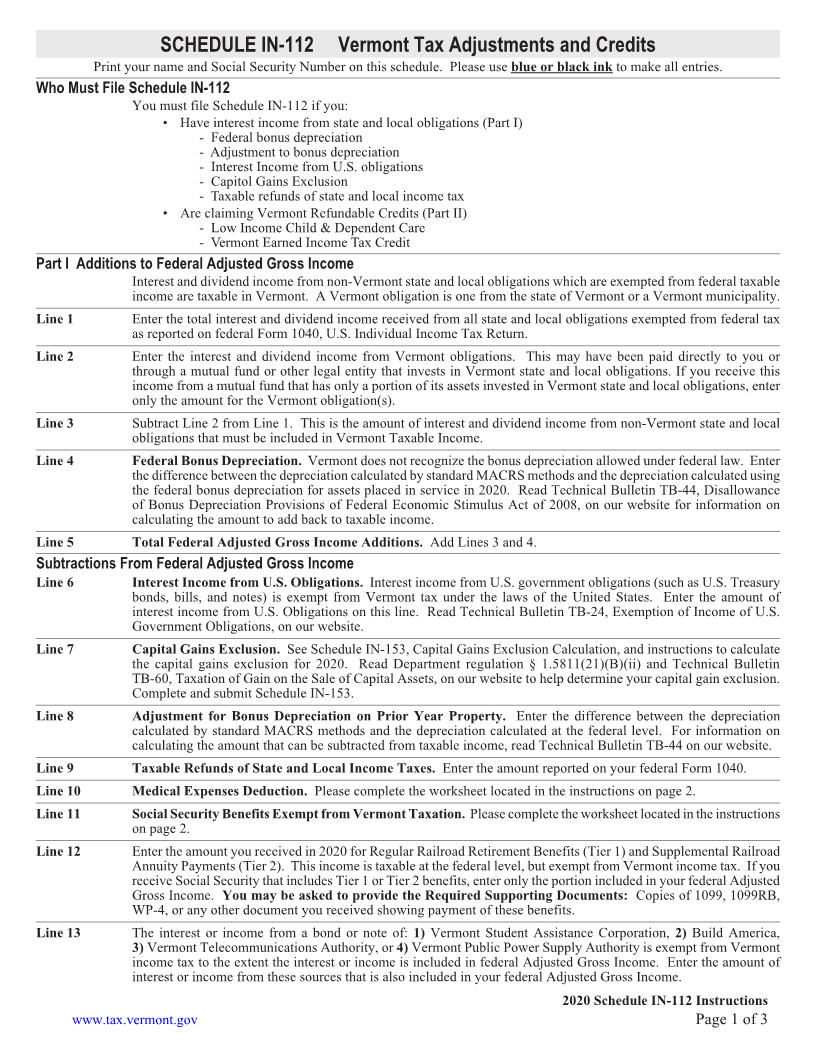
Enlarge image
SCHEDULE IN-112 Vermont Tax Adjustments and Credits
Print your name and Social Security Number on this schedule. Please use blue or black ink to make all entries.
Who Must File Schedule IN-112
You must file Schedule IN-112 if you:
• Have interest income from state and local obligations (Part I) Page 1
- Federal bonus depreciation
- Adjustment to bonus depreciation
- Interest Income from U.S. obligations
- Capitol Gains Exclusion
- Taxable refunds of state and local income tax
• Are claiming Vermont Refundable Credits (Part II)
- Low Income Child & Dependent Care
- Vermont Earned Income Tax Credit
Part I Additions to Federal Adjusted Gross Income
Interest and dividend income from non-Vermont state and local obligations which are exempted from federal taxable
income are taxable in Vermont. A Vermont obligation is one from the state of Vermont or a Vermont municipality.
Line 1 Enter the total interest and dividend income received from all state and local obligations exempted from federal tax
as reported on federal Form 1040, U.S. Individual Income Tax Return.
Line 2 Enter the interest and dividend income from Vermont obligations. This may have been paid directly to you or
through a mutual fund or other legal entity that invests in Vermont state and local obligations. If you receive this
income from a mutual fund that has only a portion of its assets invested in Vermont state and local obligations, enter
only the amount for the Vermont obligation(s).
Line 3 Subtract Line 2 from Line 1. This is the amount of interest and dividend income from non-Vermont state and local
obligations that must be included in Vermont Taxable Income.
Line 4 Federal Bonus Depreciation. Vermont does not recognize the bonus depreciation allowed under federal law. Enter
the difference between the depreciation calculated by standard MACRS methods and the depreciation calculated using
the federal bonus depreciation for assets placed in service in 2020. Read Technical Bulletin TB-44, Disallowance
of Bonus Depreciation Provisions of Federal Economic Stimulus Act of 2008, on our website for information on
calculating the amount to add back to taxable income.
Line 5 Total Federal Adjusted Gross Income Additions. Add Lines 3 and 4.
Subtractions From Federal Adjusted Gross Income
Line 6 Interest Income from U.S. Obligations. Interest income from U.S. government obligations (such as U.S. Treasury
bonds, bills, and notes) is exempt from Vermont tax under the laws of the United States. Enter the amount of
interest income from U.S. Obligations on this line. Read Technical Bulletin TB-24, Exemption of Income of U.S.
Government Obligations, on our website.
Line 7 Capital Gains Exclusion. See Schedule IN-153, Capital Gains Exclusion Calculation, and instructions to calculate
the capital gains exclusion for 2020. Read Department regulation § 1.5811(21)(B)(ii) and Technical Bulletin
TB-60, Taxation of Gain on the Sale of Capital Assets, on our website to help determine your capital gain exclusion.
Complete and submit Schedule IN-153.
Line 8 Adjustment for Bonus Depreciation on Prior Year Property. Enter the difference between the depreciation
calculated by standard MACRS methods and the depreciation calculated at the federal level. For information on
calculating the amount that can be subtracted from taxable income, read Technical Bulletin TB-44 on our website.
Line 9 Taxable Refunds of State and Local Income Taxes. Enter the amount reported on your federal Form 1040.
Line 10 Medical Expenses Deduction. Please complete the worksheet located in the instructions on page 2.
Line 11 Social Security Benefits Exempt from Vermont Taxation. Please complete the worksheet located in the instructions
on page 2.
Line 12 Enter the amount you received in 2020 for Regular Railroad Retirement Benefits (Tier 1) and Supplemental Railroad
Annuity Payments (Tier 2). This income is taxable at the federal level, but exempt from Vermont income tax. If you
receive Social Security that includes Tier 1 or Tier 2 benefits, enter only the portion included in your federal Adjusted
Gross Income. You may be asked to provide the Required Supporting Documents: Copies of 1099, 1099RB,
WP-4, or any other document you received showing payment of these benefits.
Line 13 The interest or income from a bond or note of: 1) Vermont Student Assistance Corporation, Build2)America,
3) Vermont Telecommunications Authority, or 4)Vermont Public Power Supply Authority is exempt from Vermont
income tax to the extent the interest or income is included in federal Adjusted Gross Income. Enter the amount of
interest or income from these sources that is also included in your federal Adjusted Gross Income.
2020 Schedule IN-112 Instructions
www.tax.vermont.gov Page 1 of 3

